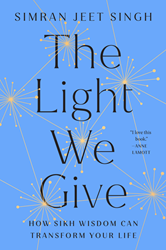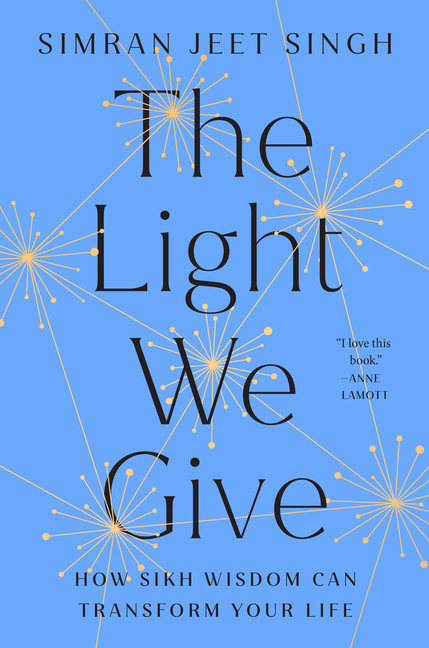The Light We Give: How Sikh Wisdom Can Transform Your Life
August 04, 2022
Author and religious scholar Simran Jeet Singh provides a deep dive into understanding key concepts of Sikhi and gives us a new way to perceive and learn from the 2012 tragedy in Oak Creek.
 The Light We Give: How Sikh Wisdom Can Transform Your Life by Simran Jeet Singh, Riverhead Books
The Light We Give: How Sikh Wisdom Can Transform Your Life by Simran Jeet Singh, Riverhead Books
On August 5, 2012, a warm and sunny Sunday morning, an armed white man entered the Sikh Temple of Wisconsin in suburban Oak Creek and opened fire on the congregants, killing six and critically wounding four—a seventh victim would be left paralyzed and die from his wounds years later. After a confrontation with police officers—one of whom miraculously survived fifteen gunshot wounds—the gunman fatally shot himself on the premises.
Other than a history of activity in white supremacist circles, he left behind no notes or other direct evidence to offer a motive for the attack. This was two weeks after the movie theater shooting in Aurora, Colorado, and four months before the Sandy Hook Elementary shooting.
I still remember the shock of hearing that a mass shooting had occurred just twenty minutes from my new home on Marquette University’s campus. I don’t know if it’s because I was only nineteen at the time, or if the world truly was a different place back then, but the occurrence of mass shootings, though steadily increasing, still felt like horrible anomalies. This was a time when I could still remember national tragedies distinctly; these days, they all blur together, commonplace as they’ve become.
I didn’t know anything about the Sikh faith at the time, and while a few weeks later I attended an on-campus talk given by Pardeep Singh Kaleka—activist and son of Satwant Singh Kaleka, who died in the attack—I didn’t follow up on educating myself much further. Mainstream coverage of the event has often focused on trying to understand the shooter’s motivations. A Google search for the Sikh Temple of Wisconsin still pulls results focused on the shooting, making it difficult to catch any glimpse into how the community moved forward in the aftermath.
Ten years later, when a book about “how Sikh wisdom can transform your life” arrived at the Porchlight offices, my interest was piqued. After all, how could I have followed news of the event, and then spent over a decade living and working just minutes away from the Sikh Temple, without ever stopping to understand what the Sikh faith was about? In picking up this book, I hoped to finally fill that knowledge gap.
Written by author and religious scholar Simran Jeet Singh, The Light We Give is billed as “part memoir, part spiritual journey,” and a significant part of this spiritual journey is Singh’s personal reckoning with the shooting at the Sikh Temple of Wisconsin.
In the first section of the book, Singh tells his family’s story while also offering a primer on the history of the Sikh tradition, referred to by Singh using the original Punjabi term of Sikhi (but also known as Sikhism in the English-speaking world). Speaking about the founder of Sikhi, Singh explains:
Nanak saw all existence as interconnected, and he decided to establish a new community that would live by a set of core principles, including equality, humility, integrity, service, and love.
As Sikhs, Singh and his family are visibly different within their San Antonio community—Singh begins wearing a turban at the age of three, when his unshorn hair is long enough to be tied up in a knot. Most of his childhood is typical—playing with friends, fighting with brothers, and so on—but there’s always the specter of racism looming, with bullying stemming not only from fellow schoolmates, but from adults.
Still, Singh and his brothers find allies, often in the context of sports, from teammates who tussle with opponents shouting slurs to coaches defending the brothers’ right to keep their turbans on while playing high school soccer and basketball. When the terrorist attacks of September 11, 2001 occur, Singh’s family is subjected to threatening phone calls. “But far more people,” Singh writes, “checked in on us—neighbors, classmates, teammates, and even strangers.” He continues:
Some brought gifts of food, others brought flowers. All of them brought their love and support. I’ll always remember my parents pointing out then, in that moment of extreme difficulty, how one finds hope in the face of adversity: Notice how much more love there is in the world than hate.
Though Singh’s parents constantly instill this spirit of perseverance in their sons, this is put to a difficult test in Singh’s adulthood—especially after the massacre at the Sikh Temple of Wisconsin. By this point, Singh is living in New York with his wife. The news of a Wisconsin gurdwara on lockdown reaches him as he’s settling in for breakfast with friends, and they're left to anxiously wait for updates from friends in the Milwaukee area. As Singh notes, he and his loved ones had accepted racism as an inevitable part of their existence. But while widescale anti-Sikh violence had been present for centuries in India, it had never occurred on the same scale in the United States. “At the time,” Singh also points out, “it was the deadliest attack on a place of worship in the United States in nearly fifty years.”
Compounding the tragedy is the media’s fumbling of the events, as reporters confuse the victims as Muslims or “sheikhs” and the gurdwara as a Hindu temple or mosque. “Even when we’re targeted and killed,” Singh writes, “and even when we have people’s sympathies, we still don’t get the dignity of being acknowledged and understood for who we are.”
Singh, along with his fellow Sikhs, is left to pick up the pieces in the aftermath of the event and find a way to heal from the tragedy. He is open and vulnerable about the difficulty of this task—he is, by his own admission, seething.
In public, I was saying all the right things—calling for peace and unity and kindness. I was showing up at vigils and on television screens, offering remarks on resilience and justice and our shared humanity. Yet I never shared the other, more complicated feelings in my heart. I couldn’t. Because underneath the surface, I felt angry and upset. I was furious that innocent people were dead because one man couldn’t control his own hatred. My heart ached as I watched people grieve their loved ones, taken from them too soon and for no good reason.
It’s in this section that Singh touches on a very universal, ongoing experience—we’re all angry and tired. These days, picking up the pieces and finding ways to move on from a tragedy has become too commonplace. There is hardly enough time to complete the cycle of grief before another tragedy strikes. The common refrain from elected officials of “thoughts and prayers” rings more and more hollow as these words are notably absent of any tangible action. That the tragedy at Oak Creek didn’t immediately spark major policy change, but instead was followed by future massacres in houses of worship like the Emanuel African Methodist Episcopal Church in 2015 and the Tree of Life synagogue shooting in 2018—among the many, many other mass shootings in schools, workplaces, concert venues, shops, et cetera—makes feelings of anger feel justified, even inevitable.
In his journey to make sense of the tragedy and to process his anger, Singh visits the Oak Creek gurdwara, and is surprised by what he finds there.
The Oak Creek Sikh community had every right to be bitter and demoralized after the attack. And yet its members showed a kind of resilience I had never seen before. One theme rang consistently throughout my dozens of conversations with the survivors: Each and every person I spoke to referred to the Sikh teaching of chardi kala, a phrase that translations roughly to “everlasting optimism.”
Whereas our lawmakers have repeatedly stalled in passing sweeping gun reform policy, Singh finds that the Oak Creek Sikh community is quickly spurred to action by the massacre. One woman, Mandeep Kaur, establishes the Chardi Kala 6K walk/run to honor survivors. Pardeep Kaleka (whose talk I’d attended at Marquette) co-founded Serve 2 Unite with former white supremacist Arno Michaelis to promote a culture of community service and interfaith unity.
Others within the Oak Creek community express, to Singh’s surprise, gratitude when he asks about the event: “I have my life,” one woman says. “So many people I love are safe. It could have been so much worse. Someone was looking out for us that day.” (Notably, during the massacre, the shooter failed to open a door leading to the gurdwara’s kitchen, where he would have found—and, no doubt, attacked—over a dozen congregants taking shelter.)
Of course, the Oak Creek Sikh community was still reeling from the pain and grief stemming from the shooting, but their faith practice allowed them to find reasons to be hopeful and grateful through such a dark event. In response, Singh takes up a new daily practice, spending just a few minutes each day to think of things for which he is grateful, from small things like a good meal to larger things like new wisdom gained.
This is not to say that everything was going right in my life at the time. Just because I was happier didn’t mean that life no longer threw challenges my way. But life felt easier, because I was able to feel joy through my hardships, just as the Sikhs in Oak Creek were able to find joy in facing theirs.
That Singh gives us a new way to perceive and learn from the tragedy in Oak Creek is valuable in and of itself. But this is, amazingly, a relatively small part of the book. What follows is a deep dive into understanding key concepts of Sikhi, from Vahiguru (the divine force that resides in everything) to ik oankar (the idea that we are all one and are filled with equal divine potential) to seva (the tradition of community service that honors our oneness). I grew up Catholic and am eternally fascinated with world theology—I nearly minored in it during my time at Marquette—so I certainly enjoyed the book from that perspective, but I don’t think the book will put off anyone who doesn’t deem themselves religious. If anything, this may be one of the few books I’ve read that so deeply grounds a religious tradition into the reality of the world around it. As Singh notes, the concept of ik oankar simply means that we are all connected:
[It] is a way of seeing and experiencing the world that evokes compassion, equity, justice, self-worth, and joy. In our world that feels increasingly polarized, in our communities that feel increasingly divided, and in our own lives that feel increasingly fragmented—radical connectedness is a response for our unanswered questions.
And indeed, there are so many unanswered questions to grapple with. After reading The Light We Give, I’ve found myself thinking about how things might have gone differently on August 5, 2012. When the shooting began, the Sikh congregants were preparing langar, the traditional communal meal that anyone, regardless of faith tradition, can attend, and that is eaten while seated on the floor as a sign of humility and equality. The gunman would have been welcomed with open arms had he decided to approach the community with curiosity. He might have come to understand how much more there is to be gained from love than from hate. He’ll never learn that lesson. But the rest of us can.
In my review of the book Milked by Ruth Conniff, I reflected on how much division has settled in between rural and urban Wisconsinites due to our inability to hold open discourse with one another. Yet, also here in Wisconsin, we have an example of what a community can look like when it stands strong in the face of tragedy. The Oak Creek Sikh community could have retreated and closed themselves off in self-preservation; instead, they have remained firm in the belief that we are all connected, and that no tragedy can sever those ties. I’m grateful that The Light We Give can raise this example up to a broader audience so that we may all learn from it.
The forecast is calling for another warm and sunny day on August 5, 2022. The Sikh Temple of Wisconsin has planned a weekend-long commemoration of the massacre’s tenth anniversary, including vigils, community meals, and even a blood drive. The event flyer on the gurdwara’s website reads, “Everyone is welcome to participate in all events.” Though our society has become even more polarized and divided than it was a decade ago, the gurdwara remains open and welcoming, and the spirit of chardi kala—of eternal optimism—endures in Oak Creek.



